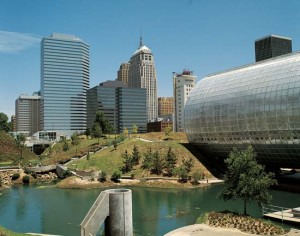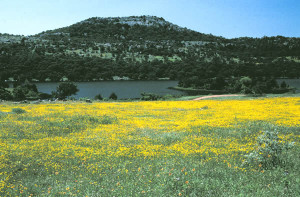
“Resilience is woven deeply into the fabric of Oklahoma. Throw us an obstacle, and we grow stronger.” – Brad Henry – Author
Oklahoma is the 20th largest state in the United States, covering an area of 69,898 square miles with 68,667 square miles of land and 1,281 square miles of water. It is one of six states on the Frontier Strip, and lies partly in the Great Plains near the geographical center of the 48 contiguous states. It is bounded on the east by Arkansas and Missouri, on the north by Kansas, on the northwest by Colorado, on the far west by New Mexico, and on the south and near-west by Texas.
The land itself and the claims to it, have formed the state of Oklahoma. Whether it was Native American tribes forced to relocate, or homesteaders who wanted to lay claim to a stake sooner rather than later, Oklahoma is a unique state with a blend of Native American and European cultures.
Geography
The high, short-grass plains of Western Oklahoma are part of the Great Plains, which are chilled by north winds in the winter and baked by intense heat in the summer. There are extensive grazing lands and wheat fields. The plains are broken here and there, notably by Black Mesa in the Panhandle and by the Wichita Mountains in the southwest. The general slope is downward to the east and central, and east Oklahoma is mostly prairie, rising in the northeast to the Ozark Mountains and in the southeast to the Ouachita Mountains. The rivers that flow from west to east across the state—the Arkansas and its tributaries, the Cimarron, and the Canadian (with the North Canadian) in the north, the Red River with the Washita and other tributaries in the south—are much more prominent in the east. Chickasaw National Recreation Area is in south Oklahoma.
Economy
Cotton, formerly the leading cash crop of Oklahoma, has been succeeded by wheat; income from livestock, however, exceeds that from crops. Many minerals are found in Oklahoma, including coal, but the one that gave the state its wealth is oil. After the first well was drilled in 1888, the petroleum industry grew enormously. Oklahoma City and Tulsa became among the great natural gas and petroleum centers of the world. Oil and gas have declined somewhat in importance today. Many of Oklahoma’s factories process local foods and minerals, but its chief economic leader includes nonelectrical machinery and fabricated metal products. Military bases and other government facilities are also important to the state’s economy.
Culture and the Arts
Oklahoma is in the nation’s middle percentile in per capita spending on the arts, ranking 17th, and contains more than 300 museums. The Philbrook Museum of Tulsa is considered one of the top 50 fine art museums in the United States, and the Sam Noble Oklahoma Museum of Natural History in Norman, one of the largest university-based art and history museums in the country, documents the natural history of the region. The collections of Thomas Gilcrease are housed in the Gilcrease Museum of Tulsa, which also holds the world’s largest, most comprehensive collection of art and artifacts of the American West.

The Oklahoma City Museum of Art contains the most comprehensive collection of glass sculptures by artist Dale Chihuly in the world, and Oklahoma City’s National Cowboy and Western Heritage Museum documents the heritage of the American Western frontier. With remnants of the Holocaust and artifacts relevant to Judaism, the Sherwin Miller Museum of Jewish Art of Tulsa preserves the largest collection of Jewish art in the Southwest United States.
In the state’s largest urban areas, pockets of jazz culture flourish, and Native American, Mexican American, and Asian American communities produce music and art of their respective cultures. The Oklahoma Mozart Festival in Bartlesville is one of the largest classical music festivals on the southern plains, and Oklahoma City’s Festival of the Arts has been named one of the top fine arts festivals in the nation.
The state has a rich history in ballet with five Native American ballerinas attaining worldwide fame. The New York Times rates the Tulsa Ballet as one of the top ballet companies in the United States.
In Sand Springs, an outdoor amphitheater called “Discoveryland!” is the official performance headquarters for the musical Oklahoma! Historically, the state has produced musical styles such as The Tulsa Sound and western swing, which was popularized at Cain’s Ballroom in Tulsa. Stillwater is known as the epicenter of Red Dirt music, the best-known proponent of which is the late Bob Childers.
Prominent theater companies in Oklahoma include, in the capital city, Oklahoma City Theater Company, Carpenter Square Theater, Oklahoma Shakespeare in the Park, and CityRep. CityRep is a professional company affording equity points to those performers and technical theater professionals. In Tulsa, Oklahoma’s oldest resident professional company is American Theater Company, and Theater Tulsa is the oldest community theater company west of the Mississippi.
Climate
Oklahoma is located in a humid subtropical region. The state lies in a transition zone between humid continental climate to the north, semi-arid climate to the west, and humid subtropical climate in the central, south and eastern portions of the state. Most of the state lies in an area known as “Tornado Alley” characterized by frequent interaction between cold, dry air from Canada, warm to hot, dry air from Mexico and the Southwestern United States, and warm, moist air from the Gulf of Mexico. The interactions between these three contrasting air currents produces severe weather (severe thunderstorms, damaging thunderstorm winds, large hail and tornadoes). Being weather aware is essential in the state.
Cost of Living
Overall, the cost of living in Oklahoma is almost 24 percent lower than the United States average. Groceries, transportation, miscellaneous goods and services, and healthcare had some of the lowest prices of all of the states, while housing and utilities, though still comparatively low, ranked slightly higher. The low prices are due to the state’s significant output of both energy and agricultural products, as well as local manufacturing of consumer goods. In addition, with an average commute time of approximately 22 minutes, gas doesn’t take up too much of a chunk of most workers’ budgets.
